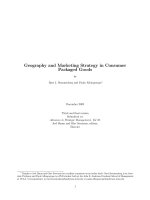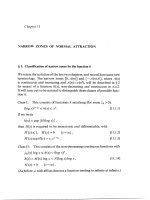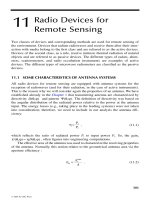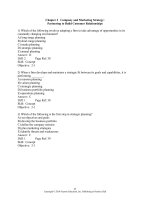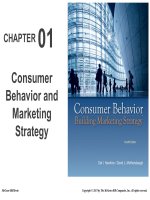Consumer behavior and marketing strategy 12e hawkins motherbaugh chapter 11
Bạn đang xem bản rút gọn của tài liệu. Xem và tải ngay bản đầy đủ của tài liệu tại đây (2.17 MB, 31 trang )
CHAPTER
11
Attitudes
and
Influencing
Attitudes
McGraw-Hill/Irwin
Copyright © 2013 by The McGraw-Hill Companies, Inc. All rights reserved.
11-2
Learning Objectives
Define attitude and its role in consumer behavior
Summarize the three components of attitudes
Discuss attitude change strategies associated with each
attitude component
Describe the elaboration likelihood model of persuasion
Describe the role of message source, appeal, and
structure on attitudes
Discuss segmentation and product development
applications of attitudes
11-3
Consumer Behavior In The News…
How are Chinese Brands Perceived?
What percent of Americans believe that
products made in China are high quality?
10%
25%
65%
Is this an increase or decrease from several
years ago?
Source: “Why the U.S. Marketplace is Prime for Chinese Products,” Advertising Age, October 10, 2011, p. 10
11-4
Consumer Behavior In The News…
How are Chinese Brands Perceived?
What percent of Americans believe that products made in
China are high quality?
10%
25% - if you said 25% you are correct!!
65%
Is this an increase or decrease? If you said increase you
are correct! Quality perceptions are on the rise, but still
low.
What attitude change strategies could Chinese
businesses use to change this belief?
Source: “Why the U.S. Marketplace is Prime for Chinese Products,” Advertising Age, October 10, 2011, p. 10
11-5
Attitudes and Influencing Attitudes
An attitude is an enduring organization of
motivational, emotional, perceptual, and
cognitive processes with respect to some
aspect of our environment.
11-6
Attitudes and Influencing Attitudes
Attitude Components and Manifestations
11-7
Attitudes and Influencing Attitudes
Emotion
Dimension
SAM (Self-Assessment Mannequin)
P
A
D
Copyright 2000 AdSAM Marketing LLC.
P=Pleasure; A=Arousal; D=Dominance
11-8
Attitude Components
Attitude Component Consistency
11-9
Attitude Components
Attitude Component Consistency
Factors that may account for inconsistencies:
1. Lack of Need
2. Lack of Ability
3. Failure to Consider Relative Attitudes
4. Attitude Ambivalence
5. Weakly Held Beliefs and Affect
6. Failure to Consider Interpersonal Influence
11-10
Attitude Change Strategies
Change the Cognitive Component
Change the Affective Component
Change the Behavioral Component
11-11
Individual and Situational Characteristics that
Influence Attitude Change
ELM
Model
11-12
Individual and Situational Characteristics that
Influence Attitude Change
Core Tenants of ELM: Part I
•
Compared to attitudes formed under the peripheral
route, attitudes formed under the central route tend to
be
stronger
more resistant to counter-persuasion attempts
more accessible from memory, and
more predictive of behaviors
11-13
Individual and Situational Characteristics that
Influence Attitude Change
Core Tenants of ELM: Part II
•
Peripheral Cues (PCs) influence persuasion under
LOW INVOLVEMENT but not HIGH
INVOLVEMENT
•
Central Cues (CCs) influence persuasion under
HIGH INVOLVEMENT but not LOW
INVOLVEMENT
11-14
Individual and Situational Characteristics that Influence
Attitude Change
BUT there are caveats and exceptions relating to cue
relevance and competitive situation.
Cue Relevance - What is a PC/CC?
•
Example: An attractive model (and her hair) may be
decision irrelevant (PC) in an ad for a car, but
decision relevant (CC) in an ad for shampoo.
•
In this case, the attractive model would influence
persuasion under high involvement for shampoos
but not for cars.
11-15
Individual and Situational Characteristics that
Influence Attitude Change
Competitive Situation - PCs can influence
persuasion under HIGH INVOLVEMENT in competitive
situations when:
•
Central cues neutralize due to homogeneity across
competing brands (PC then becomes tie breaker).
•
Attribute tradeoffs across central cues engenders
decision difficulty which PCs help to alleviate.
11-16
Individual and Situational Characteristics that
Influence Attitude Change
Consumer Resistance to Persuasion
•
Consumers are not passive to persuasion attempts
•
Consumers are often skeptical (an individual
characteristic) and resist persuasion
•
Consumers frequently infer an advertiser’s intent and
respond in light of that presumed selling intent.
11-17
Individual and Situational Characteristics that
Influence Attitude Change
Resisting Brand Attacks:
Discrediting
Discounting
Containment
11-18
Communication Characteristics that Influence
Attitude Formation and Change
Three types of communication characteristics:
1. Source Characteristics
Represents “who” delivers the message
2. Appeal Characteristics
Represents “how” the message is communicated
3. Message Structure Characteristics
Represents “how” the message is presented
11-19
Communication Characteristics that Influence
Attitude Formation and Change
Source Characteristics
1. Source Credibility
•
Persuasion is easier when the target market views the
message source as highly credible
2. Celebrity Sources
•
Celebrity sources can be effective in enhancing
attention, attitude toward the ad, trustworthiness,
expertise, aspirational aspects, and meaning transfer
3. Sponsorship
•
Sponsorships often work in much the same manner as
using a celebrity endorser
11-20
Video Application
The following Video Clip demonstrates
how Breathe Right uses celebrity
sources.
11-21
11-22
11-22
Communication Characteristics that Influence
Attitude Formation and Change
Source Characteristics
Celebrity sources widely used.
Effectiveness enhanced when
marketers match:
•image of the celebrity with
•personality of the product with
•actual or desired self-concept
of the target market.
Billboard Ad Showing Celebrity
Endorsement
11-23
Communication Characteristics that Influence
Attitude Formation and Change
Matching Endorser with Product and Target Audience
11-24
Applications in Consumer Behavior
The Mr. Clean Magic
Eraser Duo ad provides a
good example of spokescharacters.
© The Procter & Gamble Company. Used by permission.
11-25
